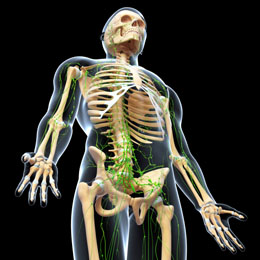Symptoms of bone cancer include pain, swelling, and fractures of the bones. Read this Buzzle article to know more about these symptoms.

Bone cancer is a type of cancer that can affect any bone in the body. There are two types of bone cancers - primary bone cancer, which begins in the bone and then metastasizes to other organs in the body or secondary bone cancer, which metastasizes from another organ and then reaches the bone. This is a relatively rare type of cancer when compared to other common types of cancer, like breast or prostate cancer. There are many symptoms, which can help detect this condition in its early stage. It is these bone cancer symptoms in children and adults that need to be singled out, so that, this condition can be diagnosed at the earliest.
Symptoms of Bone Cancer
Pain
The most common early symptom of bone cancer is pain. The extent and intensity of pain will depend on the extent of bone tumor growth. The pain can be either sharp shooting or can be dull aching in nature. It may also be intermittent or constant in nature, though most people say that the pain is worse at night and also with movement. This is one of the important symptoms of this disease in humans and will mostly be seen in and around the affected bone and will probably worsen as the cancerous cells continue to grow and apply pressure to the bone. This can increase the fragility of bones and so, sudden or severe bony pain may be indicative of an inadvertent fracture. Although this pain, especially when seen in children is often written off as a growing pain and is thus, missed out on as one of the bone cancer symptoms in children.
Swelling and Tenderness
The continuous growth of cancer cells in the bone tissues can lead to a lot of irritation and inflammation. This can lead to the skin surrounding the affected bone to swell or enlarge in size due to the growth and resultant inflammatory reaction. This can lead to a lot of discomfort and may even lead to restricted movement of the affected body parts, as is seen in cases of bone cancer in children. This swelling is also generally accompanied by other bone cancer symptoms like severe tenderness and at times, slight changes in the appearance of the surface of skin, which may be slightly red or discolored. This is especially one of the bone cancer symptoms in arms and legs which should cause concern.
Fractures
One of the other important symptom that should not be overlooked is an increase in the frequency of bone fractures. This happens because bone cancer tends to weaken the delicate bone tissue which increases the person's susceptibility to different types of bone fractures. When a person is even in the initial stages of this disease, he can end up sustaining extensive amount of bone damage even after very minor injuries like a simple fall. This may be seen in conjunction with the above symptoms of pain, swelling, and inflammation. This is one of the important symptoms and so, needs to be taken seriously. If your child is repeatedly suffering from severe bone fractures, do not write them off as play injuries as they may be a telltale sign of bone cancer.
Other Symptoms
There are many other general symptoms of bone cancer, which are also seen in almost any other type of cancer as well. These include recurring fever, chills, night sweats, anemia, malaise, tiredness, weakness, sudden and unexplained weight loss, flu like symptoms, body ache, headaches, etc.
Although bone cancer is a rare form of cancer that is diagnosed in approximately 2,300 patients each year in the United States, it is a severe type of cancer that should be treated with either radiation or chemotherapy at the earliest. Depending on the severity and stage of cancer, if bone cancer symptoms in legs are not identified in time, there may even be need for amputation of the affected limb. Hence, for bone cancer prognosis to be good, it is important to recognize the above given symptoms at the earliest so that the treatment can also be started at the earliest.


 Bone cancer is a type of cancer that can affect any bone in the body. There are two types of bone cancers - primary bone cancer, which begins in the bone and then metastasizes to other organs in the body or secondary bone cancer, which metastasizes from another organ and then reaches the bone. This is a relatively rare type of cancer when compared to other common types of cancer, like breast or prostate cancer. There are many symptoms, which can help detect this condition in its early stage. It is these bone cancer symptoms in children and adults that need to be singled out, so that, this condition can be diagnosed at the earliest.
Bone cancer is a type of cancer that can affect any bone in the body. There are two types of bone cancers - primary bone cancer, which begins in the bone and then metastasizes to other organs in the body or secondary bone cancer, which metastasizes from another organ and then reaches the bone. This is a relatively rare type of cancer when compared to other common types of cancer, like breast or prostate cancer. There are many symptoms, which can help detect this condition in its early stage. It is these bone cancer symptoms in children and adults that need to be singled out, so that, this condition can be diagnosed at the earliest.